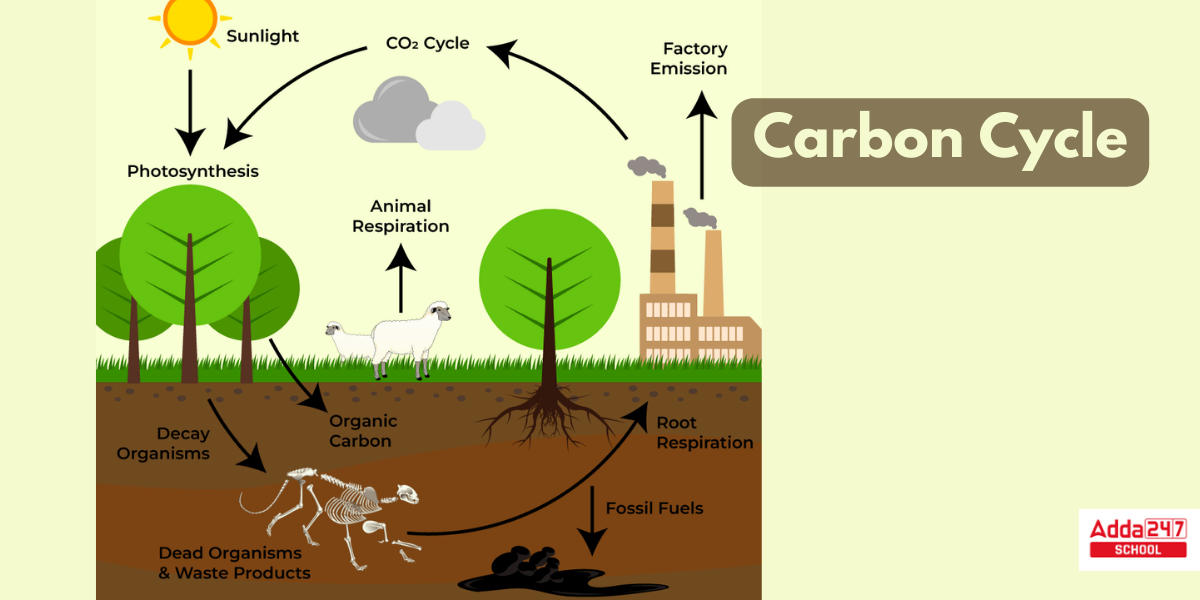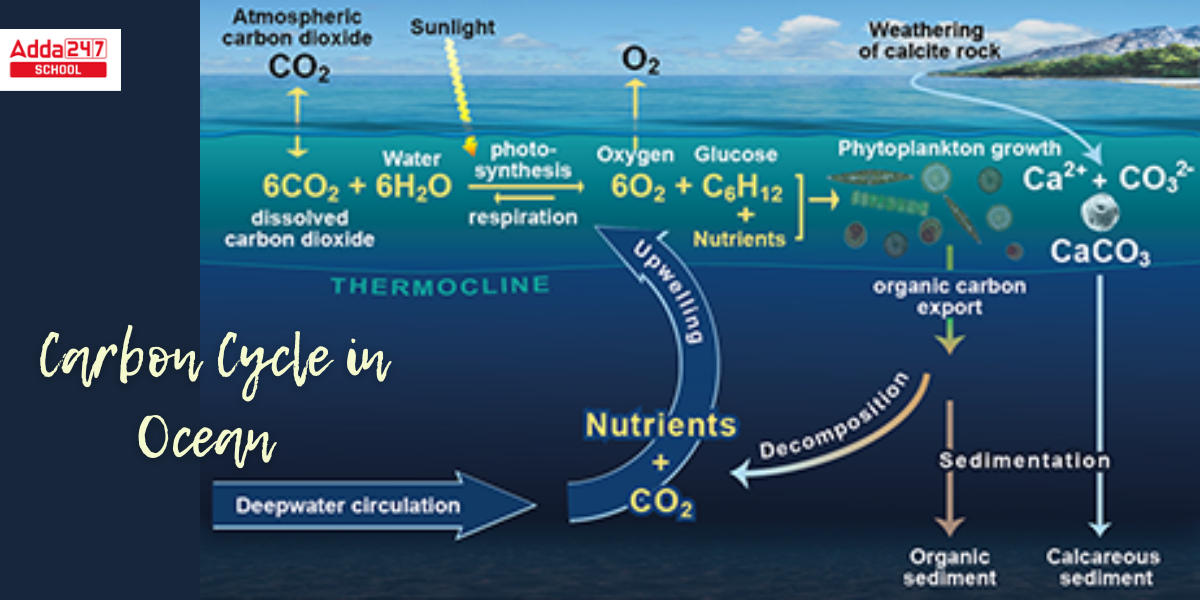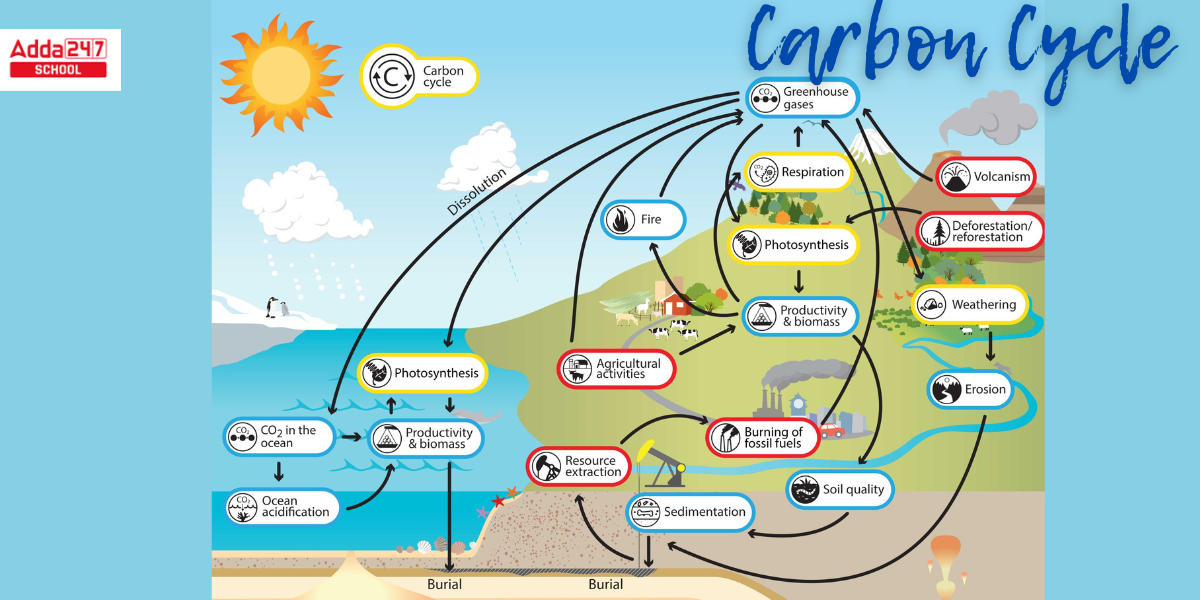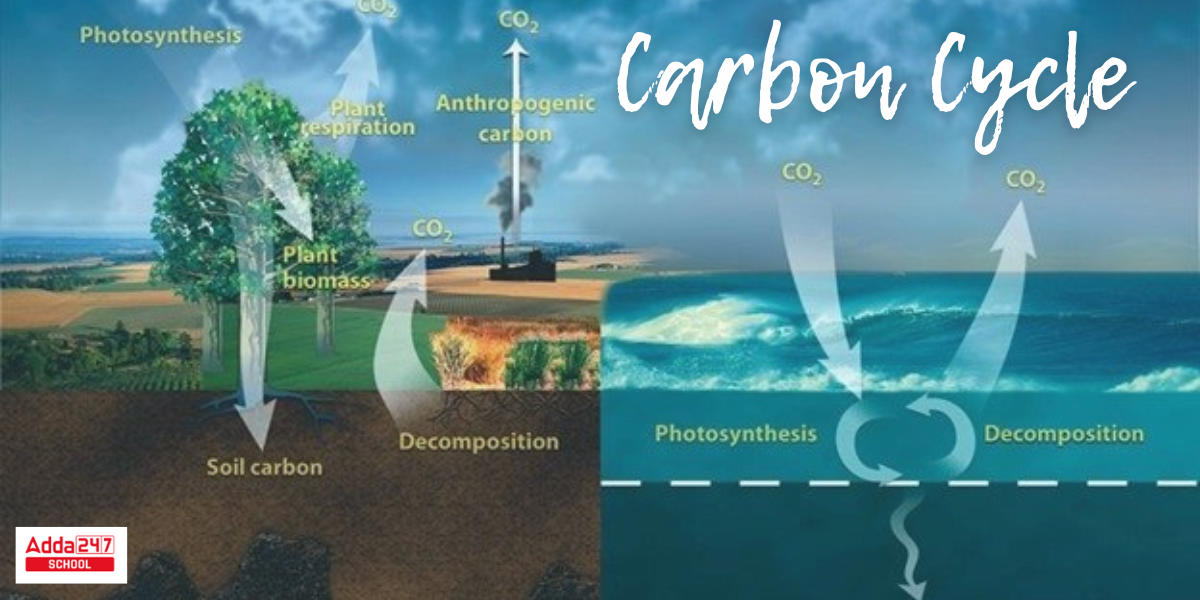Table of Contents
Carbon Cycle: The continuous movement of carbon in various forms through the atmosphere, water bodies, and land are collectively referred to as the carbon cycle. Carbon is a necessary component of all living species’ bodies. The form of fossil fuels is also economically significant to humans today. Carbon atoms make up around 18% of the human body by mass, and those carbon atoms are critical to your survival.
Carbon penetrates all terrestrial and aquatic food webs via autotrophs or self-feeders. Almost all of these autotrophs, such as plants and algae, are photosynthesizers. Carbon is also found in all organic substances, many of which are necessary for life on Earth. Continue reading this article to clearly understand how carbon flows on Earth through carbon cycles and how it impacts human life.
Carbon Cycle Definition
The movement of carbon from one storage reservoir to another via a number of mechanisms is referred to as the carbon cycle. Plants transport carbon from the atmosphere into the earth’s biosphere via photosynthesis in the food chain. They use solar energy to chemically mix carbon dioxide, hydrogen, and oxygen from water to form glucose molecules.
Animals that consume plants break down carbohydrates to obtain energy. Respiration, excretion, and decomposition all return carbon to the atmosphere or soil, thus completing the cycle. The ocean is crucial for carbon storage because it contains 50 times more carbon than the atmosphere. Some human actions, such as the use of fossil fuels and forest destruction, increase atmospheric CO2 levels and have an impact on the carbon cycle, that affects the climate and oceans.
Carbon Cycle Diagram
The majority of Earth’s carbon, approximately 65,500 billion metric tonnes, is contained in rocks. The remainder is contained in the ocean, atmosphere, plants, soil, and fossil fuels. The carbon cycle figure below depicts the movement of carbon through numerous routes.

Carbon Cycle Steps
The carbon cycle is a natural process that involves the movement of carbon between the Earth’s atmosphere, oceans, land, and living organisms. It plays a crucial role in regulating the Earth’s climate and maintaining a balance of carbon dioxide (CO2) in the atmosphere. The main steps of the carbon cycle are as follows:
- Carbon Fixation: Plants, algae, and certain bacteria use photosynthesis to absorb carbon dioxide from the atmosphere and convert it into organic compounds, such as glucose (sugar). This process “fixes” carbon into living biomass.
- Respiration: Plants and animals release carbon dioxide into the atmosphere when they respire or breathe. During this process, organic compounds are broken down to release energy, and carbon dioxide is a byproduct.
- Decomposition: When plants and animals die, or when organic matter, such as leaves and wood, decays, decomposers like fungi and bacteria break down the dead organic material. This decomposition releases carbon dioxide back into the atmosphere.
- Combustion: When humans and animals burn fossil fuels like coal, oil, and natural gas for energy, carbon that has been trapped in the Earth’s crust for millions of years is released as carbon dioxide. Additionally, wildfires and natural processes like volcanic eruptions can also release carbon dioxide through combustion.
- Exchange between Atmosphere and Oceans: The oceans act as a carbon sink, absorbing carbon dioxide from the atmosphere through a process called gas exchange. Phytoplankton, the tiny marine plants, also play a significant role in carbon fixation in the oceans, similar to plants on land.
- Carbon Sequestration: Carbon can be stored or “sequestered” for long periods in various reservoirs, such as forests, soils, and the deep ocean. Trees and forests, in particular, are vital for carbon sequestration, as they absorb and store large amounts of carbon dioxide through photosynthesis.
- Fossilization: Over millions of years, the remains of plants and animals can be buried and compressed, forming fossil fuels like coal, oil, and natural gas. These fossil fuels store carbon that was once part of the carbon cycle deep within the Earth’s crust.
The carbon cycle is a complex and interconnected process, constantly in motion and influenced by various natural and human activities. It helps maintain a balance of carbon dioxide in the atmosphere, which is crucial for regulating the Earth’s climate and supporting life on our planet. However, human activities, such as burning fossil fuels and deforestation, have disrupted the natural balance of the carbon cycle, leading to an increase in atmospheric carbon dioxide and contributing to global warming and climate change.
Carbon Cycle Types
The carbon cycle can be examined most easily as two interrelated subcycles. Although we shall examine them separately, it is critical to recognize that these cycles are interconnected. Geological processes, for example, feed and deplete the same pools of atmospheric and oceanic CO2 that life needs. The two carbon cycle categories are as follows:
- Slow Carbon Cycle – The slow carbon cycle is one that deals with the rapid exchange of carbon among living organisms.
- Fast Carbon Cycle – The fast carbon cycle is concerned with the long-term cycling of carbon via geologic processes.
Slow Carbon Cycle
The slow carbon cycle takes 100 and 200 million years to transfer through rocks, soil, ocean, and atmosphere due to a sequence of chemical processes and tectonic activity. Rain initiates the transport of carbon from the atmosphere to the lithosphere in the form of rocks. Atmospheric carbon reacts with water to generate carbonic acid, a weak acid that descends to the earth’s surface as rain. Chemical weathering occurs when acid dissolves rock and produces magnesium, potassium, calcium, or sodium ions. Ions are carried to the ocean through rivers. Every year, 10-100 million metric tonnes of carbon pass through the sluggish carbon cycle.
Carbon Cycle in Ocean / Geological Cycle
The oceans absorb more carbon than they emit. be a result, it is referred to be a “carbon sink.” Calcium ions mix with bicarbonate ions in the ocean to generate calcium carbonate, the active element in antacids and the chalky white stuff that dries on your tap if you live in a hard water location. The majority of calcium carbonate in the modern ocean is produced by shell-building (calcifying) species such as corals and plankton such as coccolithophores and foraminifera. When animals with calcium carbonate shells die, their bodies dissolve and their hard shells are left behind. Layers of shells and sediment fuse together and convert to rock over time, trapping carbon in limestone and its derivatives. When exposed to air, these limestone rocks deteriorate and carbon releases as CO2 in the atmosphere.

Carbon Cycle through Fossil
Only 80 percent of carbon-containing rock is currently made this way. The remaining 20 percent contains carbon from living things (organic carbon) that have been embedded in layers of mud. Heat and pressure compress the mud and carbon over millions of years, forming sedimentary rock such as shale. In special cases, when dead plant matter builds up faster than it can decay, layers of organic carbon become oil, coal, or natural gas instead of sedimentary rock like shale.
How is Carbon getting back into the Slow Carbon Cycle?
Through volcanoes, the slow cycle releases carbon into the atmosphere. The land and ocean surfaces of Earth are supported by multiple shifting crustal plates. When the plates meet, one descends underneath the other, and the rock it is carrying melts because of the high heat and pressure. Carbon dioxide is released as the molten rock reunites into silica crystals. In order to restart the cycle, volcanoes release gas into the atmosphere during eruptions and cover the ground with new silicate rock. Volcanoes currently release between 130 and 380 million metric tonnes of CO2 each year.
For example, if volcanic activity increases and atmospheric carbon dioxide levels rise as a result, temperatures rise, causing more rain to fall. More rain then causes more rock to dissolve, producing more ions that eventually dump more carbon on the ocean floor. Chemical weathering takes hundreds of thousands of years to restore equilibrium to the slow carbon cycle.
Fast Carbon Cycle
Carbon atoms is present in almost all organic molecules have developed strong connections with other carbon atoms, forming lengthy chains and rings. These carbon chains and rings form the foundation of living cells. A lifetime is the amount of time required for carbon to pass through the rapid carbon cycle. The rapid carbon cycle is primarily the transfer of carbon through Earth’s life forms, or the biosphere. Every year, between 1,000 and 100,000 million metric tonnes of carbon pass through the rapid carbon cycle.
Biological Carbon Cycle
The fast carbon cycle is dominated by vegetation and phytoplankton. Photosynthesis is the process through which plants absorb CO2 to generate carbohydrates. Carbon dioxide is absorbed into the cells of phytoplankton and land plants by consuming it from the atmosphere. Plants and plankton use the Sun’s energy to mix carbon dioxide (CO2) with water to generate sugar and oxygen. This is how the chemical reaction appears:
CO2 + H2O + energy → (CH2O)n +O2

How is Carbon getting back into the Slow Carbon Cycle?
There are four ways to transport carbon from vegetation and back into the atmosphere, but they all entail the same chemical reaction. Plants break down sugar to obtain the energy they require to grow. Animals consume plants or plankton and break down plant sugar to obtain energy. At the end of the growth season, plants and plankton perish and degrade (being devoured by microorganisms). Alternatively, fire consumes vegetation. In each instance, oxygen reacts with sugar to produce water, carbon dioxide, and energy. Carbon dioxide is frequently emitted into the atmosphere throughout all four processes. The basic chemical process is as follows –
CH2O + O2 = CO2 + H2O + energy
Example –The rapid carbon cycle is so closely linked to vegetative life that the fluctuation of carbon dioxide in the atmosphere can be used to predict the growth season. When few terrestrial plants are growing and many are decomposing in the Northern Hemisphere winter, atmospheric carbon dioxide levels rise. Concentrations fall during the spring, when plants begin to develop anew. This event depicts it as if the Earth is alive.
Human Effects on Carbon Cycle
Global demand for the planet’s finite fossil fuel resources has increased. Fossil fuels are depleting far quicker than geological processes can produce them. Carbon dioxide is emitted into the atmosphere when fossil fuels are burned. The increased usage of fossil fuels has resulted in elevated levels of atmospheric CO2 is also an important factor contributing to rising CO2 levels. Trees and other aspects of a forest ecosystem absorb carbon, and when the forest is removed, much of the carbon escapes as CO2. Human-caused pollution is taken up by plants or dissolved by the ocean, but these mechanisms do not totally offset the rise. As a result, atmospheric CO2 levels are increasing and will continue to climb. Increased CO2 and other greenhouse gas levels are producing significant changes in the Earth’s climate.
Impacts of Changing Carbon Cycle in Biology
Modifications in the carbon cycle have an effect on each reservoir including land, ocean, and atmosphere. Surplus carbon in the atmosphere heats the earth and encourages plant growth on land. This extra carbon has to go somewhere. Approximately 55 percent of the excess carbon emitted by humans has been absorbed by land plants and the ocean, while 45 percent has remained in the atmosphere. Marine life is at risk because too much carbon is present in the ocean’s acidic water. See how the carbon cycle impacts the land, ocean, and atmosphere individually.
Effects on Land and Plants
Although the quantity of carbon that plants take varies substantially from year to year. Nowadays plants are increasing the quantity of carbon dioxide they consume. Plants on land have absorbed around 25% of the carbon dioxide that humans have released into the atmosphere. Only a portion of this rise was caused directly by fossil fuel emissions.
Plants were able to flourish more as there was more atmospheric carbon dioxide available for conversion to plant matter via photosynthesis. Plants may grow 12 to 76 percent faster if atmospheric carbon dioxide increases by twofold, as long as nothing else, such as water scarcity, hinders their growth. Carbon fertilization refers to this increased growth.
Impacts on Ocean
Through direct chemical exchange, around 30% of the carbon dioxide that humans have released into the environment is dispersed into the ocean. Carbonic acid is formed when carbon dioxide dissolves in the ocean, increasing the acidity of the water. Since the year 1750, the pH of the ocean’s surface has declined by 0.1, representing a 30% decrease in acidity. Ocean acidification has two effects on marine life.
Carbonic acid first interacts using carbonate ions in water to generate bicarbonate. However, those exact carbonate ions are required for shell-building creatures such as coral to form calcium carbonate shells. Because there is less carbonate available, the shells become thinner as well as fragile.
Additionally, water degrades calcium carbonate more effectively the more acidic it is. In the future, this reaction will allow the ocean to absorb more CO2 since more acidic water will break down more rock, releasing more carbonate ions, and improving the ocean’s capacity to absorb CO2. Meanwhile, highly acidic water dissolves the carbonate shells of marine animals, leaving them damaged and feeble.
Carbon Cycle Impacts on the Atmosphere
It is significant that carbon, in the form of carbon dioxide, remains in the atmosphere. CO2 is the most essential gas in regulating the Earth’s temperature. Greenhouse gases such as carbon dioxide, methane, and halocarbons absorb a wide range of radiation. They absorb and then re-emit infrared radiation (heat) released by the Earth. The returned energy spreads everywhere, but some of it returns to Earth and heats the surface. Earth would be -18 degrees Celsius if greenhouse gases weren’t present.


 MH CET LLB Scorecard 2024 Out, How to Ch...
MH CET LLB Scorecard 2024 Out, How to Ch...
 GUJCET Result 2024 Link for PDF Download...
GUJCET Result 2024 Link for PDF Download...
 Rajasthan Board 5th Class Result 2024 Da...
Rajasthan Board 5th Class Result 2024 Da...















